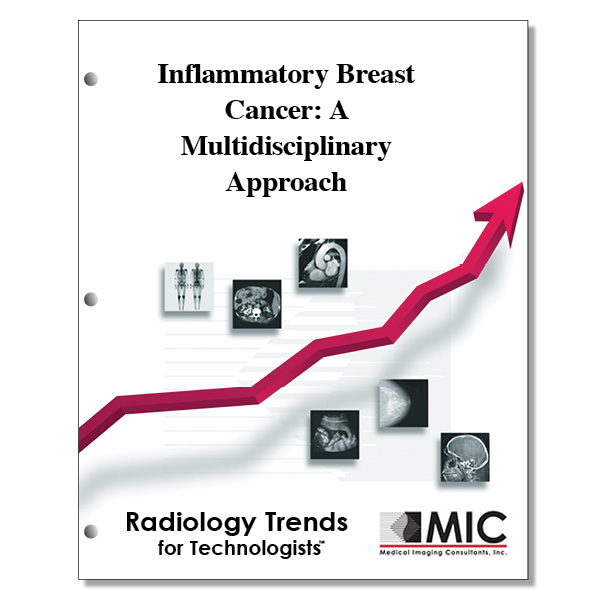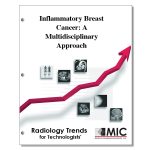

Inflammatory Breast Cancer: A Multidisciplinary Approach
A discussion of the clinical presentation of patients with inflammatory breast cancer, the major differential diagnoses, and the critical role imaging plays.
Course ID: Q00391 Category: Radiology Trends for Technologists Modalities: Mammography, MRI, Nuclear Medicine, PET, Radiation Therapy, Sonography3.0 |
Satisfaction Guarantee |
$34.00
- Targeted CE
- Outline
- Objectives
Targeted CE per ARRT’s Discipline, Category, and Subcategory classification for enrollments starting after April 6, 2023:
[Note: Discipline-specific Targeted CE credits may be less than the total Category A credits approved for this course.]
Breast Sonography: 3.00
Patient Care: 1.00
Patient Interactions and Management: 1.00
Procedures: 2.00
Anatomy and Physiology: 0.25
Pathology: 0.75
Breast Interventions: 1.00
Mammography: 3.00
Patient Care: 1.00
Patient Interactions and Management: 1.00
Procedures: 2.00
Anatomy, Physiology, and Pathology: 1.00
Mammographic Positioning, Special Needs, and Imaging Procedures: 1.00
Magnetic Resonance Imaging: 1.75
Procedures: 1.75
Body: 1.75
Nuclear Medicine Technology: 1.75
Procedures: 1.75
Endocrine and Oncology Procedures: 1.75
Registered Radiologist Assistant: 3.00
Procedures: 3.00
Thoracic Section: 3.00
Sonography: 1.75
Procedures: 1.75
Superficial Structures and Other Sonographic Procedures: 1.75
Radiation Therapy: 3.00
Patient Care: 1.00
Patient Interactions and Management: 1.00
Procedures: 2.00
Treatment Sites and Tumors: 1.00
Prescription and Dose Calculation: 0.50
Treatments: 0.50
Outline
- Introduction
- Clinical Presentation
- Differential Diagnosis
- Differentiating Primary IBC from LABC
- Skin Punch Biopsy
- Role of Imaging in Diagnosis of IBC
- Typical Mammographic Appearance
- US for Pretreatment Workup
- MR Imaging
- PET/CT with 18F Fluorodeoxyglucose for Initial Staging
- Imaging Studies to Assess Treatment Response
- FDG PET/CT to Monitor Treatment Response
- How Imaging Helps the Oncologist
- How Imaging Helps the Surgeon
- How Imaging Helps the Radiation Oncologist
- Role of Molecular Imaging
- Imaging for Recurrence, Restaging, and Metastases
- Follow-up Imaging
- Secondary IBC
- Prognosis and Significance
- Summary
Objectives
Upon completion of this course, students will:
- know the requirements for a confirmation of IBC diagnosis
- identify the three components of the tri-modality treatment regimen for IBC
- recognize uses for imaging in the IBC diagnosis and treatment processes
- recognize the common symptoms of IBC at clinical presentation
- know the common sites for IBC metastases at clinical presentation
- understand the term “differential diagnosis”
- identify the key feature that differentiates IBC from non-IBC LABC
- know the differentiators between IBC and LABC
- know the two more proliferative intrinsic molecular subtypes of breast cancer associated with IBC
- recognize the testing methods for HER2
- know when HER2 testing should occur
- be familiar with breast cancer hormone receptor status options and what this means for hormonal therapy effectiveness
- understand how the combined under-expression of one particular gene with over-expression of another could aid in IBC formation
- be familiar with the two genes which are over-expressed in IBC and contribute to the formation of emboli and increased metastases
- know the layers of tissue removed with a skin punch biopsy
- know how IBC typically appears on mammography
- identify the uses for ultrasound imaging for IBC patients
- be familiar with the BI-RADS® breast assessment categorization method
- understand the uses for MR imaging for IBC patients
- identify the most accurate imaging method for detecting IBC primary lesions
- understand the difficulties with evaluating IBC tumor size
- know the anatomical areas to be included in MR imaging of IBC patients
- identify the advantages of FDG PET/CT imaging in IBC diagnosis
- identify a possible reason for using caution with MR imaging for IBC follow up
- be familiar with the appearance of IBC response to neoadjuvant chemotherapy on MR images
- be familiar with the criteria for lesion and pathological lymph node measurement in RECIST evaluation via CT imaging
- understand the RECIST 1.1 response categories
- understand how FDG uptake is a predictor of good neoadjuvant chemotherapy response
- understand the reasoning for preoperative chemotherapy being the standard of care for IBC patients
- identify the uses for post-treatment imaging for IBC patients
- understand how imaging benefits the surgeon in IBC cases
- identify the radiation treatment fields that are often standard for IBC patients
- be familiar with some of the different radiotracers for molecular imaging
- identify potential uses of PET radiotracers for imaging IBC
- know the treatment goals for patients with metastatic IBC
